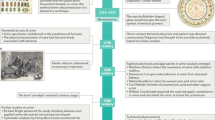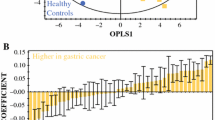Abstract
Metabolomics is a valuable tool for biomarker screening of colorectal cancer (CRC). In this study, we profiled the urinary metabolomes of patients enrolled in a prospective patient cohort (ColoCare). We aimed to determine changes in the metabolome of the longer clinical follow-up and ascertain candidate markers with possibly prognostic significance. In total, 199 urine samples from CRC patients prior to surgery (n = 97) or 1–8 days post-surgery (n = 12), and then after 6 (n = 52) and 12 months (n = 38) were analyzed using both GC–MS and 1H-NMR. Both datasets were analyzed separately with built in uni- and multivariate analyses of Metaboanalyst 2.0. Furthermore, adjusted linear mixed effects regression models were constructed. Many concentrations of the metabolites derived from the gut microbiome were affected by CRC surgery, presumably indicating a tumor-induced shift in bacterial species. Associations of the microbial metabolites with disease stage indicate an important role of the gut microbiome in CRC. We were able to differentiate the metabolite profiles of pre-surgery CRC patients from those at any post-surgery timepoint using a multivariate model containing 20 marker metabolites (AUCROC = 0.89; 95 % CI 0.84–0.95). This is one of the first metabolomic studies to follow CRC patients in a prospective setting with repeated urine sampling over time. We were able to confirm markers initially identified in case–control studies and metabolites which may represent prognostic biomarker candidates of CRC.



Similar content being viewed by others
References
Aa, J., et al. (2012). Metabolic features of the tumor microenvironment of gastric cancer and the link to the systemic macroenvironment. Metabolomics, 8, 164–173.
ACS. (2013). Cancer facts & figures 2013. Atlanta: ACS.
Barupal, D. K., et al. (2012). MetaMapp: Mapping and visualizing metabolomic data by integrating information from biochemical pathways and chemical and mass spectral similarity. BMC Bioinformatics, 13, 99.
Bates, D., Maechler, M., Bolker, B., & Walker, S. (2013). lme4: Linear mixed-effects models using Eigen and S4. http://CRAN.R-project.org/package=lme4. Accessed 15 Oct 2014.
Beck, S. A., & Tisdale, M. J. (1989). Nitrogen excretion in cancer cachexia and its modification by a high fat diet in mice. Cancer Research, 49, 3800–3804.
Bellomi, M., et al. (2005). Accuracy of computed tomography and magnetic resonance imaging in the detection of lymph node involvement in cervix carcinoma. European Radiology, 15, 2469–2474.
Benjamini, Y., & Hochberg, Y. (1995). Controlling the false discovery rate: A practical and powerful approach to multiple testing. Journal of the Royal Statistical Society: Series B (Methodological), 57, 289–300.
Biondi, A., et al. (2013). Laparoscopic vs. open approach for colorectal cancer: Evolution over time of minimal invasive surgery. BMC surgery, 13, 1471–2482.
Bone, E., Tamm, A., & Hill, M. (1976). The production of urinary phenols by gut bacteria and their possible role in the causation of large bowel cancer. American Journal of Clinical Nutrition, 29, 1448–1454.
Boutwell, R. K., & Bosch, D. K. (1959). The tumor-promoting action of phenol and related compounds for mouse skin. Cancer Research, 19, 413–424.
Carman, R. J., Van Tassell, R. L., Kingston, D. G., Bashir, M., & Wilkins, T. D. (1988). Conversion of IQ, a dietary pyrolysis carcinogen to a direct-acting mutagen by normal intestinal bacteria of humans. Mutation Research, 206, 335–342.
Chan, E. C., et al. (2009). Metabolic profiling of human colorectal cancer using high-resolution magic angle spinning nuclear magnetic resonance (HR-MAS NMR) spectroscopy and gas chromatography mass spectrometry (GC/MS). Journal of Proteome Research, 8, 352–361.
Cheng, Y., et al. (2012). Distinct urinary metabolic profile of human colorectal cancer. Journal of Proteome Research, 11, 1354–1363.
Chowdhury, R., Yeoh, K. K., Tian, Y. M., Hillringhaus, L., Bagg, E. A., Rose, N. R.,et al. (2011). The oncometabolite 2-hydroxyglutarate inhibits histone lysine demethylases. EMBO Reports, 12(5), 463–469. doi:10.1038/embor.2011.43
Denkert, C., et al. (2008). Metabolite profiling of human colon carcinoma: Deregulation of TCA cycle and amino acid turnover. Molecular Cancer, 7, 72.
Deryugina, E. I., & Quigley, J. P. (2006). Matrix metalloproteinases and tumor metastasis. Cancer and Metastasis Reviews, 25, 9–34.
Dunn, W. B., et al. (2011). Procedures for large-scale metabolic profiling of serum and plasma using gas chromatography and liquid chromatography coupled to mass spectrometry. Nature Protocols, 6, 1060–1083.
Farshidfar, F., et al. (2012). Serum metabolomic profile as a means to distinguish stage of colorectal cancer. Genome Medicine, 4, 2–13.
Ferlay, J., et al. (2013). Cancer incidence and mortality patterns in Europe: Estimates for 40 countries in 2012. European Journal of Cancer, 49, 1374–1403.
Heavey, P. M., & Rowland, I. R. (2004). Microbial–gut interactions in health and disease. Gastrointestinal cancer. Best Practice & Research Clinical Gastroenterology, 18, 323–336.
Højsgaard, U. H. S. (2013). pbkrtest: Parametric bootstrap and Kenward Roger based methods for mixed model comparison. http://CRAN.R-project.org/package=pbkrtest. Accessed 15 Oct 2014.
Kanani, H., Chrysanthopoulos, P. K., & Klapa, M. I. (2008). Standardizing GC–MS metabolomics. Journal of Chromatography B: Analytical Technologies in the Biomedical and Life Sciences, 871, 191–201.
Kern, K. A., & Norton, J. A. (1988). Cancer cachexia. JPEN Journal of Parenteral and Enteral Nutrition, 12, 286–298.
Kind, T., Tolstikov, V., Fiehn, O., & Weiss, R. H. (2007). A comprehensive urinary metabolomic approach for identifying kidney cancer. Analytical Biochemistry, 363, 185–195.
Kondo, Y., et al. (2011). Serum fatty acid profiling of colorectal cancer by gas chromatography/mass spectrometry. Biomarkers in Medicine, 5, 451–460.
Leichtle, A. B., et al. (2012). Serum amino acid profiles and their alterations in colorectal cancer. Metabolomics, 8, 643–653.
Liesenfeld, D. B., Habermann, N., Owen, R. W., Scalbert, A., & Ulrich, C. M. (2013). Review of mass spectrometry-based metabolomics in cancer research. Cancer Epidemiol Biomarkers Prevention, 22, 2182–2201.
Losman, J. A., & Kaelin, W. G., Jr. (2013). What a difference a hydroxyl makes: mutant IDH, (R)-2-hydroxyglutarate, and cancer. Genes & Development, 27, 836–852.
Ma, Y. L., et al. (2009). Ultra-high performance liquid chromatography–mass spectrometry for the metabolomic analysis of urine in colorectal cancer. Digestive Diseases and Sciences, 54, 2655–2662.
Maeda, J., et al. (2010). Possibility of multivariate function composed of plasma amino acid profiles as a novel screening index for non-small cell lung cancer: a case control study. BMC Cancer, 10, 690–698.
Mal, M., Koh, P. K., Cheah, P. Y., & Chan, E. C. Y. (2009). Development and validation of a gas chromatography/mass spectrometry method for the metabolic profiling of human colon tissue. Rapid Communications in Mass Spectrometry, 23, 487–494.
Mal, M., Koh, P. K., Cheah, P. Y., & Chan, E. C. Y. (2012). Metabotyping of human colorectal cancer using two-dimensional gas chromatography mass spectrometry. Analytical and Bioanalytical Chemistry, 403, 483–493.
Marchesi, J. R., et al. (2011). Towards the Human Colorectal Cancer Microbiome. PLoS One, 6, e20447.
Miyagi, Y., et al. (2011). Plasma free amino acid profiling of five types of cancer patients and its application for early detection. PLoS One, 6, e24143.
Moffett, J. R., & Namboodiri, M. A. (2003). Tryptophan and the immune response. Immunology and Cell Biology, 81, 247–265.
Nambiar, P. R., Gupta, R. R., & Misra, V. (2010). An “Omics” based survey of human colon cancer. Mutation Research/Fundamental and Molecular Mechanisms of Mutagenesis, 693, 3–18.
Nishiumi, S., et al. (2012). A novel serum metabolomics-based diagnostic approach for colorectal cancer. Plos One, 7, e40459.
Normanno, N., et al. (2013). Molecular diagnostics and personalized medicine in oncology: challenges and opportunities. Journal of Cellular Biochemistry, 114, 514–524.
Opitz, C. A., et al. (2011). An endogenous tumour-promoting ligand of the human aryl hydrocarbon receptor. Nature, 478, 197–203.
Owen, R. W., Spiegelhalder, B., & Bartsch, H. (2000). Generation of reactive oxygen species by the faecal matrix. Gut, 46, 225–232.
Paxton, R., Scislowski, P. W., Davis, E. J., & Harris, R. A. (1986). Role of branched-chain 2-oxo acid dehydrogenase and pyruvate dehydrogenase in 2-oxobutyrate metabolism. Biochemical Journal, 234, 295–303.
Perroud, B., et al. (2006). Pathway analysis of kidney cancer using proteomics and metabolic profiling. Molecular Cancer, 5, 1–17.
Pluskal, T., Castillo, S., Villar-Briones, A., & Oresic, M. (2010). MZmine 2: Modular framework for processing, visualizing, and analyzing mass spectrometry-based molecular profile data. BMC Bioinformatics, 11, 395–406.
Pollard, P. J., et al. (2005). Accumulation of Krebs cycle intermediates and over-expression of HIF1alpha in tumours which result from germline FH and SDH mutations. Human Molecular Genetics, 14, 2231–2239.
Qiu, Y. P., et al. (2009). Serum metabolite profiling of human colorectal cancer using GC–TOFMS and UPLC–QTOFMS. Journal of Proteome Research, 8, 4844–4850.
Qiu, Y. P., et al. (2010). Urinary metabonomic study on colorectal cancer. Journal of Proteome Research, 9, 1627–1634.
Ritchie, S. A., et al. (2010). Reduced levels of hydroxylated, polyunsaturated ultra long-chain fatty acids in the serum of colorectal cancer patients: implications for early screening and detection. BMC Medicine, 8, 1–20.
Steele, R. D. (1982). Transaminative metabolism of alpha-amino-n-butyrate in rats. Metabolism, 31, 318–325.
Sumner, L., et al. (2007). Proposed minimum reporting standards for chemical analysis. Metabolomics, 3, 211–221.
Thysell, E., et al. (2010). Metabolomic characterization of human prostate cancer bone metastases reveals increased levels of cholesterol. PLoS One, 5, e14175.
van den Berg, R., Hoefsloot, H., Westerhuis, J., Smilde, A., & van der Werf, M. (2006). Centering, scaling, and transformations: Improving the biological information content of metabolomics data. BMC Genomics, 7, 142.
Wang, W. Z., et al. (2010). Urinary metabolic profiling of colorectal carcinoma based on online affinity solid phase extraction-high performance liquid chromatography and ultra performance liquid chromatography–mass spectrometry. Molecular Biosystems, 6, 1947–1955.
Warrack, B. M., et al. (2009). Normalization strategies for metabonomic analysis of urine samples. Journal of Chromatography B, 877, 547–552.
Wu, H., et al. (2009). Metabolomic profiling of human urine in hepatocellular carcinoma patients using gas chromatography/mass spectrometry. Analytica Chimica Acta, 648, 98–104.
Xia, J., Broadhurst, D., Wilson, M., & Wishart, D. S. (2013). Translational biomarker discovery in clinical metabolomics: An introductory tutorial. Metabolomics, 9, 280–299.
Xia, J., Mandal, R., Sinelnikov, I. V., Broadhurst, D., & Wishart, D. S. (2012). MetaboAnalyst 2.0—A comprehensive server for metabolomic data analysis. Nucleic Acids Research, 40, 2.
Xiao, C., Hao, F., Qin, X., Wang, Y., & Tang, H. (2009). An optimized buffer system for NMR-based urinary metabonomics with effective pH control, chemical shift consistency and dilution minimization. Analyst, 134, 916–925.
Zhang, X., et al. (2012). Metabolite profiling of plasma and urine from rats with TNBS-induced acute colitis using UPLC–ESI–QTOF–MS-based metabonomics—A pilot study. FEBS Journal, 279, 2322–2338.
Acknowledgments
The ColoCare study has been funded by the German Consortium for Translational Cancer Research (DKTK), Matthias Lackas Foundation and the Helmholtz International Graduate School for Cancer Research, Heidelberg. We thank our collaborators, in particular Prof. Hermann Brenner, Prof. Jenny Chang-Claude and Dr. Michael Hoffmeister. We also thank all the study staff who through their energy and effort have made this study possible, particularly Dr. Clare Abbenhardt, Dr. Stephanie Zschäbitz, Thorsten Kölsch, Judith Kammer, Stephanie Tosic, Verena Widmer, Manja Ghajar Rahimi, Biljana Gigic, Werner Diehl, Rifraz Farook and many others. Last, we are truly grateful for the time and cooperation of our study participants.
Conflict of interest
The authors declare that there are no conflicts of interest.
Compliance with ethical requirements
The ColoCare study has been approved by the ethics committee of the medical faculty at the University of Heidelberg and study participants provided their written informed consent.
Author information
Authors and Affiliations
Corresponding author
Electronic supplementary material
Below is the link to the electronic supplementary material.
Rights and permissions
About this article
Cite this article
Liesenfeld, D.B., Habermann, N., Toth, R. et al. Changes in urinary metabolic profiles of colorectal cancer patients enrolled in a prospective cohort study (ColoCare). Metabolomics 11, 998–1012 (2015). https://doi.org/10.1007/s11306-014-0758-3
Received:
Accepted:
Published:
Issue Date:
DOI: https://doi.org/10.1007/s11306-014-0758-3




